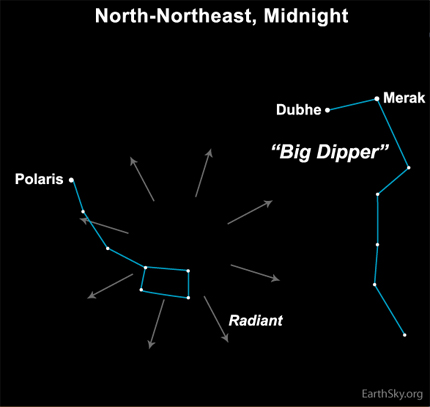Start watching for Ursid meteors (earthsky.org)
Posted by Deborah Byrd in Tonight | December 17, 2019
Start watching tonight – December 17, 2019 – for meteors in the annual Ursid meteor shower. This shower runs from about December 17 to 26 each year. It typically peaks around the December solstice, which, in 2019, comes on December 21 or 22, depending on your time zone. The shower’s peak is probably the morning of December 22, but any of the next few mornings should yield some Ursids as well. Then, after the solstice and the shower’s peak, keep watching. You still might catch some!
Generally, the Ursids are a low-key affair, offering perhaps as many as five to 10 meteors per hour in a dark sky. In rare instances, bursts of 100 or more meteors per hour have been observed at times over the past century.
The chart at the top of the page shows the Big and Little Dipper asterisms – in the constellations Ursa Major and Ursa Minor – for whom the Ursid meteor shower is named. If you look from a Northern Hemisphere location around the time of the solstice, you’ll find the Big Dipper well up in the north-northeast at around 1 a.m. That’s about the time of night you’ll want to start watching this meteor shower.
In 2019, at this shower’s peak, the moon is in waning phase. It’ll be bright in the sky on the mornings of December 18 or 19, but, by the time of the Ursids’ peak on the mornings of December 22 or 23, the moon will be a thin crescent. It won’t greatly intrude on what’s usually a low-key spattering of Ursid meteors on the mornings of the peak.

***
not much more: https://earthsky.org/tonight/ursid-meteor-shower-active-around-wintter-sosltic
While this isn't the showiest meteor shower -- and you have to get up late to see it -- at least it's pretty darned easy to find ! Just look north and you're sure to spot the Big Dipper, and following the line formed by the two "pointer" stars, Merak & Dubhe, the tail of the Little Dipper -- in fact, the Pole Star, Polaris. Even people who don't know their constellations can easily locate the Dippers.
Since the radiant (point of origin for meteor trails) is so close to the North (Celestial) Pole, these should be visible from almost the entire Northern Hemisphere.
